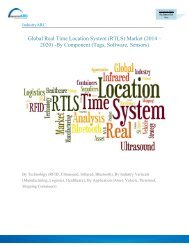Global Consumer 3D Printing Market Analysis and Forecast (2013 - 2018): Hardware, Software and Service Level Opportunities Analysis
Consumer 3D printing is a niche sub-segment of the global 3D printing market. The term additive manufacturing or 3D printing refers to process of getting printed an object of any shape from a digital model. The process is performed through a digital technology i.e. CAD (Computer aided design). Additive manufacturing is one of the most widely accepted emerging technology and its services are being utilized by various industries like medical, automotive, consumer products, military, aerospace, academics, construction and others. 3D printers are generally used in industries as discussed previously, but entry level printers which can produce products of relatively smaller volumes are currently available for purchase by households, hobbyists, educational institutions as these printers come at a very low cost. Makerbot is considered as the pioneer of this market which was followed by other companies like Solidoodle, Ultimake etc. These companies take up and improve on the specifications from the open source models in the RepRap community. This report focuses on the household or consumer 3D printers market opportunity and growth prospects. The market has been segmented by geography as North America, Europe, Asia, and Rest of the World (RoW). Market size and forecast is provided for each of these regions. A detailed qualitative analysis of the factors responsible for driving and restraining growth of the consumer 3D printing market and future opportunities are provided in the report. Competitive landscape for each of the product types is highlighted and market players are profiled with attributes of company overview, financial overview, business strategies, product portfolio and recent developments. Market shares of the key players for 2012 are provided. The prominent players profiled in this report are 3Dsystems, Stratasys, Solidscape and others. The report contains the most detailed and in-depth segmentation of the Quantum dots market in SSL, solar cells and displays applications.
Consumer 3D printing is a niche sub-segment of the global 3D printing market. The term additive manufacturing or 3D printing refers to process of getting printed an object of any shape from a digital model. The process is performed through a digital technology i.e. CAD (Computer aided design). Additive manufacturing is one of the most widely accepted emerging technology and its services are being utilized by various industries like medical, automotive, consumer products, military, aerospace, academics, construction and others.
3D printers are generally used in industries as discussed previously, but entry level printers which can produce products of relatively smaller volumes are currently available for purchase by households, hobbyists, educational institutions as these printers come at a very low cost. Makerbot is considered as the pioneer of this market which was followed by other companies like Solidoodle, Ultimake etc. These companies take up and improve on the specifications from the open source models in the RepRap community.
This report focuses on the household or consumer 3D printers market opportunity and growth prospects. The market has been segmented by geography as North America, Europe, Asia, and Rest of the World (RoW). Market size and forecast is provided for each of these regions. A detailed qualitative analysis of the factors responsible for driving and restraining growth of the consumer 3D printing market and future opportunities are provided in the report.
Competitive landscape for each of the product types is highlighted and market players are profiled with attributes of company overview, financial overview, business strategies, product portfolio and recent developments. Market shares of the key players for 2012 are provided. The prominent players profiled in this report are 3Dsystems, Stratasys, Solidscape and others.
The report contains the most detailed and in-depth segmentation of the Quantum dots market in SSL, solar cells and displays applications.
Create successful ePaper yourself
Turn your PDF publications into a flip-book with our unique Google optimized e-Paper software.
THE ARC ADVANTAGE<br />
An analytical model lies at the core of our process, ensuring logical consistency<br />
throughout our research. We complement the model with secondary data <strong>and</strong><br />
interviews with industry experts to reflect the latest trends. With our final expert<br />
validation, we provide you with only the most accurate <strong>and</strong> actionable intelligence.<br />
THE ARC PROCESS<br />
Analytical<br />
Method<br />
Base Method<br />
Consolidation<br />
Method<br />
Delphi<br />
Verification<br />
1. Granular<br />
breakdown of<br />
drivers into<br />
factors<br />
2. Validate all<br />
factors in terms<br />
of their present<br />
impact on the<br />
market<br />
3. Assign weights<br />
to these factors in<br />
terms of their<br />
relevance <strong>and</strong><br />
impact on the<br />
market<br />
1. Get a topdown<br />
estimate of<br />
the market<br />
2. Follow it up<br />
with a bottom-up<br />
estimate of the<br />
market<br />
3. Check<br />
forconsistency<br />
<strong>and</strong> new growth<br />
factors that are<br />
relevant over the<br />
next 10 Years<br />
1. Granular<br />
breakdown of<br />
drivers into<br />
factors<br />
2. Validate all<br />
factors in terms<br />
of their present<br />
impact on the<br />
market.<br />
3. Assign weights<br />
to these factors in<br />
terms of their<br />
relevance <strong>and</strong><br />
impact on the<br />
market.<br />
1. Verify the<br />
findings of the<br />
model with<br />
experts from<br />
across the value<br />
chain<br />
2. Verify the<br />
findings with<br />
players across<br />
small <strong>and</strong> large<br />
enterprises<br />
3. Tweak the<br />
model <strong>and</strong> add<br />
new factors<br />
4. Build the<br />
Analytical Model<br />
4. Build the Base<br />
model<br />
4. Build the<br />
Consolidated<br />
Model<br />
4. Finalize the<br />
ARC Model<br />
ANALYTICAL MODEL BASE MODEL CONSOLIDATED MODEL ARC MODEL<br />
IndustryARC | 13

















